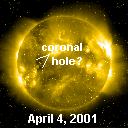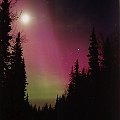|   SPACE WEATHER SPACE WEATHER
Current
Conditions
Solar Wind
velocity: 735.3 km/s
density:1.4 protons/cm3
explanation | more data
Updated: Today at 2247 UT
X-ray Solar Flares
6-hr max: C4 1650 UT Apr04
24-hr: M1 1220 UT Apr04
explanation | more data
Updated: Today at 2250 UT
Daily Sun: 04 Apr '01 
The giant sunspot 9393 is vanishing over the Sun's western limb, but a new large sunspot (9415) has emerged to take its place as a potential source of solar activity. AR9415 unleashed an X1-class flare on Monday.
Sunspot Number: 228
More about sunspots
Updated: 03 Apr 2001
Radio Meteor Rate
24 hr max: 29 per hr
Listen to the Meteor Radar!
Updated: 04 Apr 2001 Interplanetary Mag. Field
Btotal: 11.2 nT
Bz: 5.2 nT north
explanation | more data
Updated: Today at 2247 UT Coronal Holes:

A small coronal hole is growing east of the Sun's central meridian. The many speckles in this image are caused by energetic solar particles striking the camera -- the result of an ongoing radiation storm around Earth. Image credit: SOHO Extreme UV Telescope.
More about coronal holes
 SPACE WEATHER SPACE WEATHER
NOAA
Forecasts
Solar Flares: Probabilities for a medium-sized (M-class) or a major (X-class) solar flare during the next 24/48 hours are tabulated below.
Updated at 2001 Apr 04 2200 UT
| FLARE | 24 hr | 48 hr | | CLASS M | 80 % | 65 % | | CLASS X | 30 % | 20 % |
Geomagnetic Storms: Probabilities for significant disturbances in Earth's magnetic field are given for three activity levels: active, minor storm, severe storm
Updated at 2001 Apr 04 2200 UT Mid-latitudes | 24 hr | 48 hr | | ACTIVE | 20 % | 35 % | | MINOR | 30 % | 25 % | | SEVERE | 20 % | 15 % |
High latitudes | 24 hr | 48 hr | | ACTIVE | 20 % | 35 % | | MINOR | 30 % | 15 % | | SEVERE | 25 % | 25 % |

Web server provided by
VPS Hosting
| What's Up in Space -- 4 Apr 2001
Subscribe to Space Weather News! IMPACT: Monday's super solar flare hurled a coronal mass ejection (CME) into space. The bulk of the CME was directed away from Earth, but not all of it. At 1500 UT (11:00 am EST) on April 4th an interplanetary shock wave generated by the CME struck our planet's magnetosphere. [550 kb CME movie]  So far geomagnetic activity has been minor. Soon after the shock wave hit, the interplanetary magnetic field (IMF) around Earth turned north -- a condition that is unfavorable for Northern Lights. High-latitude sky watchers should nevertheless remain alert for auroras after local nightfall. SUPERFLARE: The most powerful solar flare in at least 25 years erupted near sunspot 9393 on April 2nd. The "X20" blast was even stronger than a well-known flare in March 1989 that led to the collapse of a power grid in Quebec. There were no such calamities this time because the explosion was mostly (but not entirely; see above) directed away from Earth.  The flux of 10 MeV solar protons surrounding our planet remains approximately 10,000 times normal. Such radiation levels pose no appreciable hazard to air travelers, astronauts or satellites. The ongoing radiation storm is a NOAA S2-category event. SUNSPOT 9393: Before the end of this week AR9393 --the largest sunspot since 1991-- will disappear completely as it rotates over the Sun's western limb. - Sunspot animation -- NEW watch sunspot 9393 evolve in this SOHO white light solar movie spanning March 24th - April 2nd.
- Big Sunspots in History --compare 9393 to other giant sunspots of the last century.
 AURORAL WEEKEND: A powerful geomagnetic storm raged for more than 24 hours last weekend, dazzling sky watchers who saw aurora borealis as far south as Mexico. The storm began at 0100 UT on March 31st (8 p.m. EST on March 30th) when a coronal mass ejection (CME) struck Earth's magnetosphere. The leading edge of the CME was dense (150 protons/cm3) and strongly magnetized -- traits that can (and did) give rise to intense auroras. Veteran aurora watchers describe the display as arguably the most photogenic of the current solar cycle. AURORAL WEEKEND: A powerful geomagnetic storm raged for more than 24 hours last weekend, dazzling sky watchers who saw aurora borealis as far south as Mexico. The storm began at 0100 UT on March 31st (8 p.m. EST on March 30th) when a coronal mass ejection (CME) struck Earth's magnetosphere. The leading edge of the CME was dense (150 protons/cm3) and strongly magnetized -- traits that can (and did) give rise to intense auroras. Veteran aurora watchers describe the display as arguably the most photogenic of the current solar cycle.
See the Weekend Aurora Gallery WEB LINKS: NOAA FORECAST | GLOSSARY | SPACE WEATHER TUTORIAL | LESSON PLANS | BECOME A SUBSCRIBER | 
Potentially Hazardous Asteroids (PHAs) are space rocks larger than approximately 100m that can come closer to Earth than 0.05 AU. None of the known PHAs are on a collision course with our planet, although astronomers are finding new ones all the time. [more]
On 4 Apr 2001 there were 299 known Potentially
Hazardous Asteroids ASTEROIDS GALORE: March was a good month for asteroid hunters. Between March 21st and 31st astronomers discovered seven Earth-approaching space rocks (click to view 3D orbits): 2001 FM129, 2001 FE90, 2001 FB90, 2001 FD58, 2001 FC58, 2001 FA58 and 2001 FO32. There is no danger of a collision with any of these asteroids. Earth-asteroid encounters (Mar 1 - Apr 30) 
- TOTAL LUNAR ECLIPSE: On Jan. 9, 2001, the full Moon glided through Earth's copper-colored shadow. [gallery]
- CHRISTMAS ECLIPSE: Sky watchers across North America enjoyed a partial solar eclipse on Christmas Day 2000 [gallery]
- LEONIDS 2000: Observers around the globe enjoyed three predicted episodes of shooting stars. [gallery]
 Feb. 21, 2001: Nature's Tiniest Space Junk -- Using an experimental radar at the Marshall Space Flight Center, scientists are monitoring tiny but hazardous meteoroids that swarm around our planet. Feb. 15, 2001: The Sun Does a Flip -- NASA scientists who monitor the Sun say our star's enormous magnetic field is reversing -- a sure sign that solar maximum is here. Jan. 25, 2001: Earth's Invisible Magnetic Tail -- NASA's IMAGE spacecraft, the first to enjoy a global view of the magnetosphere, spotted a curious plasma tail pointing from Earth toward the Sun. Jan. 4, 2001: Earth at Perihelion -- On January 4, 2001, our planet made its annual closest approach to the Sun. Dec. 29, 2000: Millennium Meteors -- North Americans will have a front-row seat for a brief but powerful meteor shower on January 3, 2001. Dec. 28, 2000: Galileo Looks for Auroras on Ganymede -- NASA's durable Galileo spacecraft flew above the solar system's largest moon this morning in search of extraterrestrial "Northern Lights" Dec. 22, 2000: Watching the Angry Sun -- Solar physicists are enjoying their best-ever look at a Solar Maximum thanks to NOAA and NASA satellites. MORE SPACE WEATHER HEADLINES |

